HOA Reserve Study 101: Reserve Studies for HOAs
Download Our Guide
Why Are Reserve Studies for HOAs So Important?

As a trustee one of your top responsibilities is to conduct an effective HOA reserve study, as well as maintain and improve the HOA reserve funds of the community (or communities) you manage. But it can be tricky to budget for new amenities like a dog park or gate houses, or shared, common-area assets that will need to be replaced or upgraded years down the line such as roofing or building facades. The good news is, by partnering with an experienced property management company like FirstService Residential that knows how to put effective reserve funding strategies in place, your board can properly plan for these eventualities and avoid, as much as possible, having to impose special assessments.
- HOA reserve funds in Massachusetts are community savings accounts that serves as a cushion — protecting your association’s finances from the burden of necessary future expenditures. By design, a reserve account grows over time through regular funding that comes from a percentage of your association’s dues.
- A reserve study assists with an association’s long-term financial planning by taking into consideration the current status of the reserve fund and determining a regular funding contribution that will offset ongoing wear and tear and/or achieve future community enhancements. The reserve study is comprised of two parts — a comprehensive physical analysis of the current condition of your community’s assets, and a detailed financial analysis.
Both the reserve fund and reserve study are critical components of the budgeting process that help ensure the long-term financial security of your community.
If you would like more information about effective budgeting strategies and best practices, download our new budget guide, 8 Secrets to a Better Association Budget Process, today.
Determine the Benefits of Association Reserve Funding
In this video, you can learn more about the importance of reserve studies. The video addresses questions like: “what is a reserve study and how often do you need on?”, “what is the bidding and development process and how do you navigate it?” and more!
The key to protecting the fiscal health of your community is committing to the consistent funding of your reserve fund over time. By doing so, you will create the foundation for healthy HOA reserve studies and funds and your association will realize three distinct benefits:
-
Peace of mind - A reserve fund gives association members greater confidence and comfort in knowing money will be there when it is needed.
-
Market value preservation – When reserves exist to support shared assets in a community, the market value of properties within that community are better maintained.
- Equitable cost participation – One of the main advantages of establishing and maintaining a reserve fund is that it ensures all residents who are using and enjoying community assets are contributing to their costs. Without reserves, a special assessment may be needed whereby only those residents who are living in your community at the time an asset needs to be replaced would be impacted. By funding reserves over time, you can ensure that generations of owners share in the costs of assets.
Your governing documents will detail if a reserve fund must be established for your community. In fact, some states require fully funded reserves. Those documents will also outline what procedures must be followed for contributing to your reserves and if funding can be postponed or sidestepped all together if the majority of your residents agree to it. A good property management company will offer sound guidance on establishing and maintaining effective HOA reserve studies and funding of your reserves. At FirstService Residential, it is an essential component of the support we offer communities for successful, long-term financial planning.
Understand the importance of a reserve study as it relates to HOA reserve funds in Massachusetts

An operating fund is leveraged in order to fund the daily expenses to keep HOA operations running smoothly. This may include a variety of line items, including: insurance premiums, services to keep amenities clean and operational, maintaining common areas, property management payment, legal and office expenses and more. Conversely, HOA reserve studies in Massachusetts are used for large-scale projects that drive up the value of your community and budget for future community updates. Typically, they are used for replacing outdated structures, such as a pool or clubhouse, for example.
When it comes to reserve funds, association members may be strict about how the moneys are allocated. Any expense coming out of this budget must align to the community’s governing documents, rules and regulations, as well as accountability and bylaws. Some potential examples of the uses of reserve funds may include:
-
The replacement of a filter at the HOA’s pool
-
Replacement fees involving fencing projects
-
Large construction and renovation projects
-
Major landscaping updates
-
The painting of community structures (ie: clubhouses)
-
The construction of a new common area or community park
-
Roof replacements on some of the common area buildings
It can be challenging for a board to identify all the items in its community that will eventually need the support of reserve funds, when those items will need to be developed, upgraded or replaced and how much it will cost in the future. That’s where the reserve study comes in.
By assessing the condition of common-area assets within your community (like club houses, lobbies and pool areas), identifying future replacement costs and recommending an annual contribution amount for the reserve fund, the study can better position your board for long-term financial success.
At FirstService Residential, we highly recommend that you enlist the services of a third-party professional such as a reserve specialist to conduct your reserve study. These pros will have a thorough understanding of all the assets in your community that should be considered and if/when they should be added to your reserve inventory.
They will also have intimate knowledge of your state’s requirements regarding reserve funds and studies. And most importantly, they will offer your board an unbiased and sometimes much needed voice to your budgeting process. Please reach out to FirstService Residential if you need help identifying a reserve specialist in your area. Our North American footprint is such that we can make these recommendations for communities of all sizes and markets.
It is also important to treat your reserve study as a living, breathing document that should be regularly reviewed and updated. But remember, it’s a guide. You don’t have to hold fast to the recommended timeframes.
“For example, your reserve study may indicate that a roof should be replaced in 30 years. If you are 28 years in, it still looks great and you’ve done all the preventive maintenance, you can decide to get another five years out of it and adjust that component accordingly,” said Bobet Bennett, senior vice president – financial services with FirstService Residential.
It’s also strongly recommended to regularly update your reserve study. For newer communities, the suggested cadence is every three years. After a decade of existence, communities should consider updates every other year and detailed reviews of the study should occur annually. Again, your state may dictate the schedule you must follow for reserve studies/updates. A good property management company will be able to provide this information to you and inform you on the most efficient steps to take to enhance the value of your community.
Determine Maintenance vs. Reserve Components
Properly categorizing your community’s common area components is one of the challenges that comes with managing reserves. Some items will require regular maintenance such a pressure washing sidewalks and window cleaning, others will need to be replaced like roofs and mechanical equipment, and still others will require both such as pools and carpeting.
To ensure your community components will last until they are due to be replaced, you must budget for maintenance costs every year. If you don’t, you may end up having to replace them before the reserve study’s replacement due date and impose a special assessment or take out a loan.
At the same time, you must make a reserve contribution each year to be properly prepared for covering replacement costs when they are scheduled to occur.
Deciding whether items are maintenance vs. replacement (or both) will ultimately determine if they will be listed in your annual operating budget or as part of your reserve inventory. Usually, less expensive items are included in the operating budget, and costlier items are assigned as reserve components so their replacement costs can be financed over a longer time period. If you need help determining whether an item should be included in your operating budget or reserve inventory, consult with your auditor or property management company.
More and more associations, especially for communities that are decades old, are starting to address infrastructure components as part of their budget planning process as well. These are components that last a very long time, are generally out-of-sight and as such, are not often thought of — like sewers. A good practice to follow is to add infrastructure items to your reserve components list when they reach the halfway mark of their expected life spans.
As your board takes on the responsibility of budgeting for your association and ensuring your HOA reserve funds are in a strong place, be sure to rely on your reserve fund and reserve study. They are both indispensable tools that can help keep your community’s long-term financial plan in check.
If you would like more information about effective budgeting strategies and best practices, download our new budget guide, 8 Secrets to a Better Association Budget Process, today.